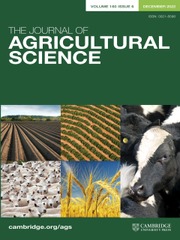Article contents
Fertilizer nitrogen addition to winter wheat crops in England: comparison of farm practices with recommendations allowing for soil nitrogen supply
Published online by Cambridge University Press: 27 March 2009
Summary
Measurements were made during 1987/88 on 20 winter wheat crops grown in Essex, four on each of five soil types – sandy loam, sandy silt loam, silt loam, calcareous clay loam and clay loam – where winter wheat, dried peas, winter faba beans or winter oilseed rape was the previous crop in 1986/87. The sites had a wide range of soil mineral N (SNS), 40–198 kg/ha N, as NH4 plus NO3, in the 0–90 cm soil profile. Optimum grain yield and fertilizer N could not be estimated but yields measured in the absence of fertilizer N enabled evaluation of the use of SNS on its own and the response to fertilizer N (187 ± 32 kg/ha). For crops receiving fertilizer N, each tonne of grain was associated with 35kg of total available N in the soil profile (SNS + fertilizer N); a little over 63% of this N was found in the above-ground parts of the crops at harvest. Fertilizer N requirement was predicted as:
Fertilizer N needed (kg/ha) = [35 × predicted grain yield (t/ha)]–SNS (kg/ha)
An arbitrary assumption of 8 t/ha grain for every site (fortuitously the same as the average of 8·07t/ha measured in crops given fertilizer N) showed that differences between added and predicted amounts of N differed by c. 30 kg/ha for only seven of the 20 sites, mostly because of large SNS or yields much less than 8 t/ha. Measuring SNS and using the formula would be justified in the majority of winter wheat crops, provided reliable yield estimates could be made in time.
Information
- Type
- Crops and Soils
- Information
- Copyright
- Copyright © Cambridge University Press 1996
References
REFERENCES
- 5
- Cited by

